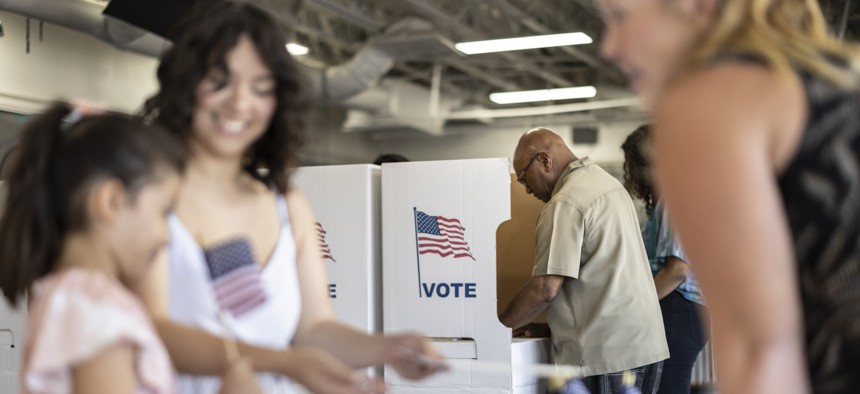Election Officials Have Been Largely Successful in Deterring Cyber Threats, CISA Official Says

LPETTET/istockphoto
The head of CISA’s National Risk Management Center pointed to public-private partnerships and enhanced resource sharing activities as key to defending against outside threats to voting systems.
Increased coordination between federal agencies, election officials, and private sector election vendors has helped deter an influx of cyber threats directed at U.S. voting systems, an election official from the Cybersecurity and Infrastructure Security Agency said on Thursday during an event hosted by the Election Assistance Commission and Pepperdine University.
Mona Harrington, the acting assistant director of CISA’s National Risk Management Center—which includes the agency’s election security team—said that since election systems were designated as critical infrastructure in 2017, “the attacks have become much more sophisticated and the volume of attacks has certainly increased.” But with the partnerships that CISA and election officials have built, along with the products and services currently being used to mitigate potential risks, election officials have many of the tools needed to deter both nation state actors and non-nation state adversaries.
Harrington noted that all 50 states have deployed CISA-funded or state-funded intrusion detection sensors in their systems, known as Albert sensors, and that hundreds of election officials and private sector election infrastructure partners have signed up for a range of CISA’s cybersecurity services, from recurring scanning of their systems for known vulnerabilities on internet-connected infrastructure to more in-depth penetration testing.
“Technology and the evolving threat landscape has shaped the role of election officials, and election officials have seen a significant expansion of their duties beyond simple election administration to a position more akin to technology and information managers and IT managers,” Harrington said.
The series of election-related panels hosted by EAC and Pepperdine University were held in recognition of the Help America Vote Act, the 2002 law that established the EAC and made sweeping changes to voting systems and election administration following the 2000 presidential election. Known as HAVA, the law, in part, requires EAC to develop voluntary voting system guidelines which outlines the security, reliability and accuracy requirements that voting systems are tested against in order to receive certification under the EAC’s testing and certification program.
Last year, the EAC adopted its voluntary voting system guidelines 2.0 to further enhance the testing requirements for voting systems. No election vendors have received VVSG 2.0 certification thus far, however, and voting systems are unlikely to be certified under the new guidelines until at least 2024.
Beyond the updated guidelines for securing and certifying voting systems across the country, some of the panelists discussed the need to develop standards for securing non-voting systems as well, such as electronic poll books and voter registration systems. EAC announced in 2020 that it was partnering with the Center for Internet Security to launch a non-voting election system technology verification pilot program, although it remains unclear whether this pilot will lead to broader adoption or the issuance of non-voting system guidelines from EAC. A report on the pilot, called RABET-V, was released in January 2021.
Traci Mapps, the vice president of SLI Compliance—a certification body that operates the EAC-accredited voting system test laboratory—said that all components of the election process, including non-voting systems, should receive testing to ensure they are meeting set standards.
“As a voting system test lab we’ve participated in a lot of that testing, but I do feel that there should be a central set of standards that these systems are tested to so that they can be certified and help election officials to make sure that these systems are secure,” Mapps said.
Even as EAC, election officials, and private sector election infrastructure partners continue to enhance their collaborative efforts to secure voting systems, there remains a need for greater public awareness of the multi-level safeguards and testing that go into securing U.S. elections. Mapps noted that the majority of states already require that their voting systems are certified by the EAC or tested in a voting system test lab, and that sharing that information more broadly with the general population could help combat some of the misinformation and disinformation that threatens to undermine public trust in election results.
“Time and time again, I talk to people and they have no idea that there are voting system test labs out there that are doing testing on voting systems,” Mapps said. “And I think educating people to let them know about the testing that’s being done may be helpful.”
But election officials and CISA remain confident about the security of election systems, particularly with the strong safeguards that are already in place to deter nation state actors and other cyber adversaries. And when it comes to some of the more outlandish conspiracies surrounding the 2020 election—including the unfounded claims that election results were somehow filtered through networks in other countries—Harrington said that existing procedures and controls largely mitigate the potential for that type of large-scale outside intrusion.
“The evidence is not there, but there are also a lot of controls that are in place to mitigate that kind of risk,” Harrington said, citing logic and accuracy testing, post-election tabulation audits and other security measures as some of the common procedures that would identify such an occurrence.

NEXT STORY: Cybersecurity Grants Are Coming. Are You Ready?






